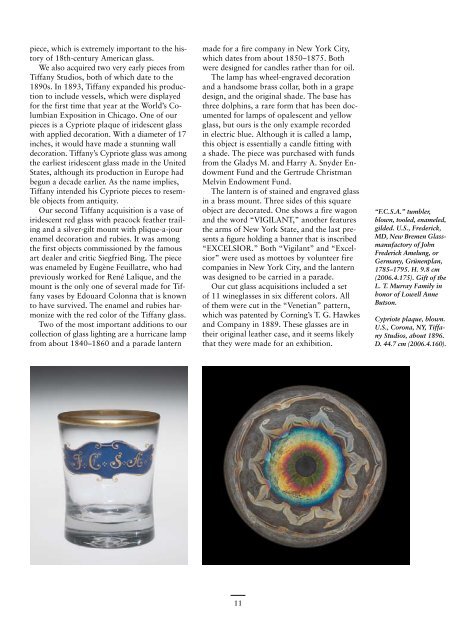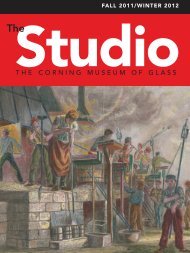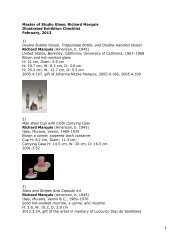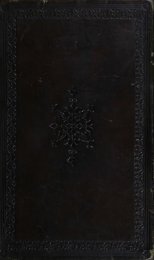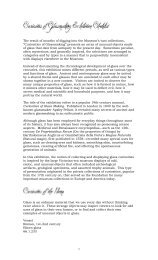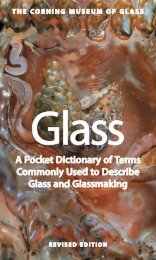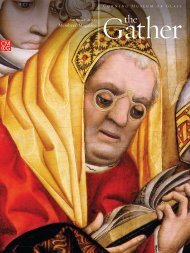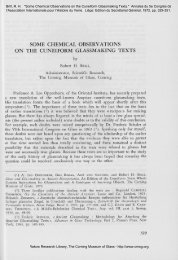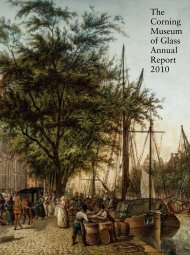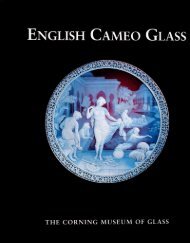Glass of the Maharajahs - Corning Museum of Glass
Glass of the Maharajahs - Corning Museum of Glass
Glass of the Maharajahs - Corning Museum of Glass
Create successful ePaper yourself
Turn your PDF publications into a flip-book with our unique Google optimized e-Paper software.
piece, which is extremely important to <strong>the</strong> history<br />
<strong>of</strong> 18th-century American glass.<br />
We also acquired two very early pieces from<br />
Tiffany Studios, both <strong>of</strong> which date to <strong>the</strong><br />
1890s. In 189 , Tiffany expanded his production<br />
to include vessels, which were displayed<br />
for <strong>the</strong> first time that year at <strong>the</strong> World’s Columbian<br />
Exposition in Chicago. One <strong>of</strong> our<br />
pieces is a Cypriote plaque <strong>of</strong> iridescent glass<br />
with applied decoration. With a diameter <strong>of</strong> 17<br />
inches, it would have made a stunning wall<br />
decoration. Tiffany’s Cypriote glass was among<br />
<strong>the</strong> earliest iridescent glass made in <strong>the</strong> United<br />
States, although its production in Europe had<br />
begun a decade earlier. As <strong>the</strong> name implies,<br />
Tiffany intended his Cypriote pieces to resemble<br />
objects from antiquity.<br />
Our second Tiffany acquisition is a vase <strong>of</strong><br />
iridescent red glass with peacock fea<strong>the</strong>r trailing<br />
and a silver-gilt mount with plique-a-jour<br />
enamel decoration and rubies. It was among<br />
<strong>the</strong> first objects commissioned by <strong>the</strong> famous<br />
art dealer and critic Siegfried Bing. The piece<br />
was enameled by Eugène Feuillatre, who had<br />
previously worked for René Lalique, and <strong>the</strong><br />
mount is <strong>the</strong> only one <strong>of</strong> several made for Tiffany<br />
vases by Edouard Colonna that is known<br />
to have survived. The enamel and rubies harmonize<br />
with <strong>the</strong> red color <strong>of</strong> <strong>the</strong> Tiffany glass.<br />
Two <strong>of</strong> <strong>the</strong> most important additions to our<br />
collection <strong>of</strong> glass lighting are a hurricane lamp<br />
from about 1840–1860 and a parade lantern<br />
made for a fire company in New York City,<br />
which dates from about 1850–1875. Both<br />
were designed for candles ra<strong>the</strong>r than for oil.<br />
The lamp has wheel-engraved decoration<br />
and a handsome brass collar, both in a grape<br />
design, and <strong>the</strong> original shade. The base has<br />
three dolphins, a rare form that has been documented<br />
for lamps <strong>of</strong> opalescent and yellow<br />
glass, but ours is <strong>the</strong> only example recorded<br />
in electric blue. Although it is called a lamp,<br />
this object is essentially a candle fitting with<br />
a shade. The piece was purchased with funds<br />
from <strong>the</strong> Gladys M. and Harry A. Snyder Endowment<br />
Fund and <strong>the</strong> Gertrude Christman<br />
Melvin Endowment Fund.<br />
The lantern is <strong>of</strong> stained and engraved glass<br />
in a brass mount. Three sides <strong>of</strong> this square<br />
object are decorated. One shows a fire wagon<br />
and <strong>the</strong> word “VIGILANT,” ano<strong>the</strong>r features<br />
<strong>the</strong> arms <strong>of</strong> New York State, and <strong>the</strong> last presents<br />
a figure holding a banner that is inscribed<br />
“ExCELSIOR.” Both “Vigilant” and “Excelsior”<br />
were used as mottoes by volunteer fire<br />
companies in New York City, and <strong>the</strong> lantern<br />
was designed to be carried in a parade.<br />
Our cut glass acquisitions included a set<br />
<strong>of</strong> 11 wineglasses in six different colors. All<br />
<strong>of</strong> <strong>the</strong>m were cut in <strong>the</strong> “Venetian” pattern,<br />
which was patented by <strong>Corning</strong>’s T. G. Hawkes<br />
and Company in 1889. These glasses are in<br />
<strong>the</strong>ir original lea<strong>the</strong>r case, and it seems likely<br />
that <strong>the</strong>y were made for an exhibition.<br />
11<br />
“F.C.S.A.” tumbler,<br />
blown, tooled, enameled,<br />
gilded. U.S., Frederick,<br />
MD, New Bremen <strong>Glass</strong>manufactory<br />
<strong>of</strong> John<br />
Frederick Amelung, or<br />
Germany, Grünenplan,<br />
1785–1795. H. 9.8 cm<br />
(2006.4.175). Gift <strong>of</strong> <strong>the</strong><br />
L. T. Murray Family in<br />
honor <strong>of</strong> Lowell Anne<br />
Butson.<br />
Cypriote plaque, blown.<br />
U.S., Corona, NY, Tiffany<br />
Studios, about 1896.<br />
D. 44.7 cm (2006.4.160).


